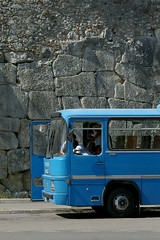
The Poste Italiane have issued a new stamp to represent Molise, to accompany Valle d'Aosta, Veneto, and Sicilia in their "Regioni d'Italia" series. Its design features the so-called "Fontana Fraterna," a well-known monument in the city of Isernia with an interesting history. It was supposedly built in the 14th century by the Rampiniani family in honor of Pope Celestine V, a native of Isernia, incorporating Roman stonework from the family tomb of the Pontii family (of Judean procuratorship fame). Of these suppositions, only the fact that it incorporates Roman spolia can be verified.
 The idea that the fragmentary inscription ---]AE PONT[--- could be read famili]ae Pont[iae was disposed of by Mommsen, who read it Nerv]ae pont[ifici (CIL IX, 2636). M. Buonocore suggests that it need not pertain to Nerva, but could refer to a prominent local family.
The idea that the fragmentary inscription ---]AE PONT[--- could be read famili]ae Pont[iae was disposed of by Mommsen, who read it Nerv]ae pont[ifici (CIL IX, 2636). M. Buonocore suggests that it need not pertain to Nerva, but could refer to a prominent local family.Franco Valente, in his intriguing article "La Fraterna di Isernia, la fontana dei misteri," traces the long and winding history of the fountain. The most certain fact is that current fountain was rebuilt "exactly," albeit in a new location, after its destruction during the Second World War.
Earlier than that, the going gets dicey. The fountain, or a fountain, has been destroyed by earthquakes, rebuilt, moved, expanded, incorporated bits from other fountains, moved again -- maybe. It bears a curious Latin inscription on one end, which Valente dates to the 13th century and reads:
fons iste / cuius posit(ores) / Rampiniani / me parabis

I'm not convinced that the inscription must have originally referred to this particular fountain. Given the circumstances, I'm not sure where I would draw the line between this fountain and a different fountain. Is it really one fountain suffering numerous vicissitudes, undergoing numerous reconstructions, or a family of fountains, genetically linked as it were by incorporating material from predecessors?
(Stamp news source: primapaginamolise.it; Fountain history, F. Valente, 'La Fraterna di Isernia, la fontana dei misteri'; Fountain photos: my Flickr photos)






